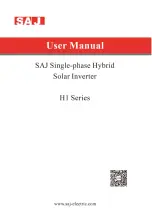
15
TROUBLESHOOTING
Common Audio/Visual Problems
“Buzzing” sound in audio systems
Some inexpensive stereo systems and “boom boxes” emit a buzzing sound from their
speakers when operated from the Power Inverter. This occurs because the power
supply in the electronic device does not adequately filter the modified sine wave
produced by the inverter. The only solution to this problem is to use a higher quality
sound system that incorporates a higher quality power amplified supply.
Television Interference
The Inverter is shielded to minimize interference with TV signals. However, in some
instances, some interference may still be visible, particularly with weak TV signals. Try
the following corrective measures:
• Position the inverter as far as possible from the television, the antenna and the
antenna cables. Use an extension cable, if necessary.
• Adjust the orientation of the inverter, the antenna cables and the TV power cord to
minimize interference.
• Make sure the antenna feeding the television provides an adequate (“snow free”)
signal and that high quality, shielded antenna cable is used.
• Do not use the inverter to operate high-power appliances or tools at the same time
you are using it to operate the TV.
• Make sure the inverter’s case is properly grounded (see “Permanent Installation
Procedure” on page 12).
Resetting the Unit
To reset the inverter, turn the ON/OFF Power Switch to the “OFF” position, then back
“ON” agin.
Fault Protection and Troubleshooting Guide
INVERTER POWER SWITCH TURNED ON
Trouble/Indication Possible Cause
Suggested Remedy
No AC output —
DC input is below 10 volts
Recharge or replace battery.
red LED lit
Excessive appliance load
Turn unit OFF. Reduce the load, wait for the
— thermal shutdown
inverter to cool down, then turn the unit ON
again.
Low battery alarm
Low battery voltage
Recharge battery. Remove load from the
sounds continuously
inverter while recharging battery.
Bad connection or wiring
Tighten all DC connections.
Motorized power tool
Excessive start-up load
If appliance does not start, appliance is
will not start
drawing excessive voltage and will not work
with inverter.
Motorized power tool
Purely inductive load
Make the load not purely inductive. Operate
does not operate at
an incandescent lamp at the same time as
correct speed
motor.
Television/radio
Snow in picture,
Keep inverter and antenna distant from each
interference
“buzzing” sound
other. Use shielded antenna. Connect antenna
to amplifier and ground inverter case.
14
Operating Tips
For best operating results, the inverter should be placed on a stable, flat surface. The
inverter should only be used in locations that meet the following criteria:
DRY — Do not allow water or other liquids to come into contact with the inverter.
COOL — Surrounding air temperature should be between –1°C and 40°C (30°F and
105°F). Keep the inverter away from direct sunlight, when possible.
WELL-VENTILATED — Keep the area surrounding the inverter clear to ensure free air
circulation around the unit. Do not place items on or over the inverter during
operation. The unit will shut down if the internal temperature gets too hot.
SAFE — Do not use the inverter near flammable materials or in any locations that may
accumulate flammable fumes or gases. This is an electrical appliance that can briefly
spark when electrical connections are made or broken.
CAUTION
Rechargeable Devices
Certain rechargeable devices do not operate well from a modified sine
wave inverter. They only operate properly from a standard household
outlet, which provides a pure sine wave. Therefore, the manufacturer
recommends that these types of devices be operated from a standard
household outlet only, not from the inverter.
This problem does not occur with most battery-operated equipment.
Most of these devices use a separate charger or transformer that is
plugged into an AC receptacle. The Power Inverter is easily capable of
running most chargers and transformers.
CARE AND MAINTENANCE
Storage
1. Ideal storage temperature range is 50-68°F (10-20°C).
2. Store and use the inverter in a cool, dry place with adequate ventilation.
3. Avoid locations that are exposed to heating units, radiators, direct sunlight or
excessive humidity or dampness.
Fuse Replacement
This inverter is equipped with multiple internal fuses. Normally, these fuses will not
“blow” unless there is a serious problem inside the unit.
Internal fuses are
replaceable; however, only trained personnel should attempt fuse
replacement.
If the unit is damaged during fuse replacement, the warranty may be
voided. The manufacturer recommends contacting Technical Support, toll-free, at
(866) 584-5504.
Preventive Maintenance
Inverters require minimal maintenance. For optimum performance, the manufacturer
recomments periodically performing the following preventive maintenance.
1. Turn OFF the inverter using the front panel ON/OFF Power Switch.
2. Remove the DC power fuse.
3. Check and tighten all electrical connections, including the ground.
4. Using a non-metallic vacuum cleaner hose, vacuum the air slots and fan area.
5. Clean the outside of the unit using a damp (not wet) cloth.
6. Wipe unit surfaces thoroughly with a dry cloth.
7. Re-insert the fuse and resume operation.
VEC049_50_51GM_Manual_041906 4/20/06 4:09 PM Page 14




























